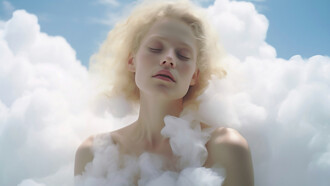During this era of overstimulation and image overload, the Jacquemus aesthetic here is a visual breath of fresh air. The ensemble—a matching light-colored jacket and trousers—is an aesthetic that is at once serene and insistent. There is no resort to logos, prints, or explicit styling cues. Instead, the point is made: form, fabric, and presence are sufficient to insist on attention without gratuitousness. The silhouette is loose but tailored, a compromise between leisurewear and tailoring, and invites us to question what formal wear in contemporary masculinity can be.
Textile as narrative
The embossed reptile texture of the fabric—almost imperceptible at first glance—is turned into a major narrative device. It evokes the haptic memory of crocodile skin, the traditional symbol of exoticism and luxury. But its execution in monochrome beige reverses expectations. Rather than bemoaning opulence at the top of its price-tag lungs, the material whispers it. The implication is that luxury today is less spectacle and more subtlety. Jacquemus reformulates material codes on a very French, poetic level—turning what was once aggressive (the exotic animal hide) inward, intellectual, and wearable.
Masculinity remade
This reshapes the visual lexicon of masculinity. Traditional menswear has long been founded on angular shapes, dark colors, and aggressive tailoring—mirroring older ideas about control and dominance. Jacquemus presents a different masculinity instead: softer, inward-looking, and founded on ease. The loose tailoring and dropped shoulders allow the wearer to occupy space in a gentle way, not an aggressive one. That is not weakness, but power reconfigured. The new male ideal, as evidenced here, welcomes comfort and feeling as sources of power.
The accessory that grounds
The brown suede handbag provides a bold counterpoint to the creamy neutral suit. The bag is soft, tied, and apparently personal—perhaps even sentimental. The bag's texture repeats the crocodile theme of the ensemble, building a textural narrative that is consistent. But its warmth injects humanity into the cool ensemble. It has the texture of something with a history—handed down, perhaps—that beckons memory and emotional investment in a man's wardrobe. In a fashion landscape where accessories have been traditionally gendered, this object will not be binary. It is not for women or men; it's for the telling.
The power of proportion
Jacquemus' mastery of proportion is writ large in the hyperbolic length of the trousers. Letting the pants break and pool slightly over the shoes can be interpreted as a conscious deviation from traditional menswear dicta, which often prize a clean hem. This pooling introduces softness and movement. It creates a dialogue between the garment and the ground—between presence and gravity. It also implies boyish nostalgia, where clothes once worn too large become a symbol of growth. In this way, proportion is a metaphor for transformation.
Neutral as language
Color is normally the first thing to catch the eye in fashion, but colour here is deliberately muted. The neutral color scheme is a conceptual ground rather than a decorative fillip. Beige and camel are not aesthetic afterthoughts but linguistic tools. They demand contemplation rather than response. Neutrals also democratize the garment, allowing it to be reinterpreted across cultural lines. In a global fashion economy, this strategic neutrality allows a garment to transcend geographic and gendered lines.
Fashion as sculpture
The photograph's composition—with its stark contrast and sharp shadows—elevates the garment to the status of art object. It recalls the classical sculptural tradition, where garments were carved into stone and not preserved for use, but for form. Jacquemus is continuing that tradition by presenting fashion as spatial, not just visual. The pose, the lighting, and the absence of visual clutter work to reinforce the idea that clothing is an architectural extension of the body—a structure that can contain emotion, memory, and identity.
The signature of Jacquemus
The discreet branding at the base of the photo speaks volumes about the designer's motivation. By eschewing overt brand talk, Jacquemus places emphasis firmly on design integrity. The modesty is rare in a period of brand overkill. Yet it's precisely this restraint that signals the brand's understated confidence. Jacquemus has evolved from Mediterranean whimsy to minimalist sophistication, and this image documents that transition—a move towards global appeal without sacrificing poetic intimacy.
Masculinity sans exaggeration
It resists, at its core, the notion that masculinity must be performative. There is no armor here, no need to occupy space with aggressive lines or blaring graphics. Instead, there is repose. The masculinity that is communicated is intellectual, emotional, and spatial. It speaks in what it leaves out as much as in what it speaks. In this way, the Jacquemus man is a figure for contemporary humanism—where vulnerability is not hidden but worn gracefully.
Fashion with intention
This single photo by Jacquemus concentrates an entire philosophy: that fashion needn't shout in order to be heard. In fact, in its silence, it has more to communicate. The deliberate choices in texture, proportion, color, and styling here do not simply present an item of clothing but a manner of thought. In a cultural moment searching for both identity and calm, Jacquemus suggests menswear as poetry—slow, spare, and deeply human.
The article draws inspiration from Jacquemus' 2025 lookbook.















